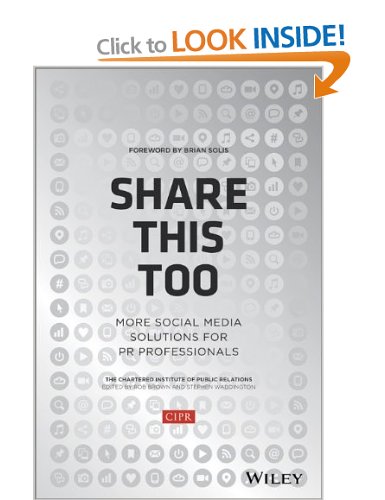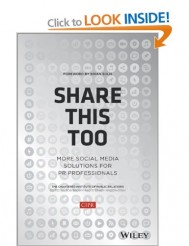Share this too – Part Two
25 October 2013 By Northern Lights

 Last week I reviewed the CIPR’s new book on social media, Share this Too. I wanted to pull out a nugget from each of the 30 contributors, so covering the rest here, part two.
Last week I reviewed the CIPR’s new book on social media, Share this Too. I wanted to pull out a nugget from each of the 30 contributors, so covering the rest here, part two.
1. Sharon O’Dea
Sharon’s chapter on gamification disturbed me – particularly having this in a book for the PR industry. She talks about games being big business – generating $78 billion in revenue in 2011, which will already be far surpassed. But honestly is this PR, social media or communications? She gives a few case studies, such as Samsung Nation which she cites as gaining customer loyalty and Foldit for its powerful means to engage with products or brands. It really challenges how we think of ‘engagement’.
2. Paul Fabretti
There are some good tips from Paul Fabretti on rethinking behaviours in community engagement
- Always on – how will you handle out of hours interactions?
- Shares – how will you handle good and bad feedback?
- Collaboration – are you ready for consumers working together?
- Creativity – are you allowing customers to be creative – and what is the contingency plan when this works against you?
3. Michael Litman
Michael Litman covers ‘curation’, defined as ‘the process of analysing and sorting web content and presenting it in a meaningful and organised way around a specific theme’. Just as someone might do on Twitter – or even this blog, I guess. Pulling out information and re-presenting it in a niche place where people know what to expect?
4. Russell Goldsmith
Russell covers a number of technologies and Google+ Hangouts sounded of interest – for live video conferences. I may need to do more research but the video on this below just seems to be another version of a messaging service?
5. Stephen Davies, Scott Seaborn, Dan Tyte and Matt Appleby
These four chapters dealt with mobile media, apps, Foursquare and the visual web – including Pinterest and infographics.
6. Kevin Ruck
This chapter on using social media in employee engagement was one of my favourites. It is an area employers of all sizes and in all sectors are grappling with how open, share how much, what and security. Kevin outlines ways that CIPR members use social media to contribute to employee engagement
- Real-time information
- Authentic
- Transparent dialogue
- It is not moderated
- Involve people earlier in the strategy
- Wider input on water cooler conversations
- Enables to cut through layers of bureaucracy
- Generates more interest
He also looks at ways to overcome security concerns, whether senior managers should blog and connecting with employees who do not have easy access to the intranet or email.
7. Hanna Basha
A sensible look at the law in social media and, like so much in this field, makes the point that ‘risks and threats of litigation operate the same online’ (as in print and elsewhere).
8. Chris Norton
Chris Norton looks at social media in crisis management with really useful tips. I liked his 13 point plan of issues to consider when preparing and managing a crisis
- Create a plan and run test exercises
- Use tools like SMS, Yammer, blogs and private groups to liaise with crisis team
- Build a dark site in preparation
- Create a response strategy for negative comments
- Use social monitoring tools – track the sources of comments and who is influencing whom
- Acknowledge any issues, be prepared for negative responses no matter what
- Assume people are intelligent (really like this one!)
- Use pay per click (PPC) advertisements to combat negative websites
- Use repetition to ensure people remember positives
- Have a friendly network of online influencers to help disseminate messages
- Don’t engage everybody – target influencers and keep record of who you engaged with
- Using video content is more authentic than written statements
- Don’t get involved in arguments
While this is a great list, not sure I would agree with points 8, 9 and 11. It will depend on the circumstance, but some of this could feel spammy and not authentic.
9. Stephen Waddington
This chapter looks at Wikipedia and reputation management, with a very good section on registering with Wikipedia and engaging with original editors if there are inaccurate articles.
10. Becky McMichael
Healthcare professionals are increasingly using platforms such as doctors.net to communicate and Becky looks at the global healthcare landscape. Last year, I was asked to co-author an ebook on how mental health practitioners could use social media and I was surprised at how advanced pockets of the medical world are in its use. Inevitably there is a long way to go in other areas.
11. Rachel Miller
Rachel’s chapter on corporate communications cites a number of case studies which I will look at in more detail: Target Ovarian Cancer charity, the Local Government Association, VMA Group, Altimeter Group and Aviva Investors. We produced our own tips on producing a social media policy for employees but have to say absolutely love the example from Mayo Clinic Center she gives
|
Don’t lie. Don’t pry. Don’t cheat. Can’t delete. Don’t steal. Don’t reveal
|
12. Stuart Bruce
Stuart looks at social media in corporate social responsibility (CSR) and says ‘it is perhaps no surprise that some of the companies that rank highest for CSR performance are also some of those demonstrating the most innovation in using social media’.
13. Richard Bailey
We’ve always been a big fan of Richard’s – not least because he quotes our ebook for students on using social media to get a job. He includes great examples of how students are using social media to establish their credibility and profile – it’s worth any PR professional to look at these and see what they are doing.
14. Jane Wilson
For us, this chapter has the most resonance – the social CEO. Most of this book is aimed at those working in big brands and consumer campaigns, not what most PR professionals work in day-to-day. However, whoever your client, they all have a CEO and there is always a debate, should they be using social media in a personal or corporate capacity? Her practical tips for CEOs are great
- Listening is important
- Size doesn’t always matter (ie you don’t have to be FTSE 100 to be heard)
- Don’t bare all
- Be authentic
- You can be wrong sometimes
- Share the limelight
- Consider the regulatory environment
- Don’t panic when it hits the fan
15. Jed Hallam, Katy Howell, Gemma Griffiths and Philip Sheldrake
These chapters look at the ‘business of social’ – doing business internationally, setting up social businesses, demonstrating value and changing organisational mindsets.
16. Richard Bagnall, Drew Benvie, Andrew Bruce Smith, Simon Collister
The final section talks about ‘future proofing’ the PR industry and covers evaluation, metrics and the power of ‘big data’.
Anyone working in communications will pick up numerous nuggets from this book. The disappointment is that it is so focused on brands such as Asda, Nike, Red Bull and Coca Cola – only a small percentage of our industry works in this consumer-focused field. But this just provides the opportunity for the CIPR’s next book to look at the work that PR professionals across the country are working in and particularly with a bigger focus on B2B?
Stephen Waddington tweeted to ask me what I think is missing from Share This Too? Above all it has to be thought leadership blogging, strategic LinkedIn and using social media to target and build new relationships online with policymakers, academics and new clients.
What else would you like to see in the next one?
